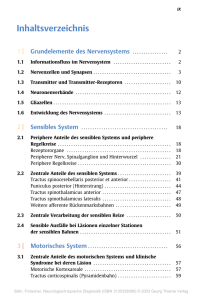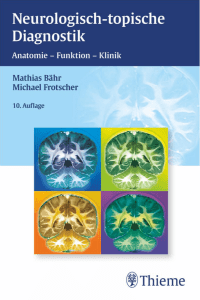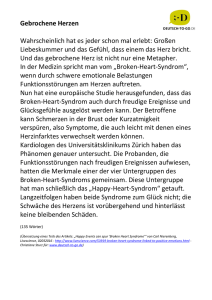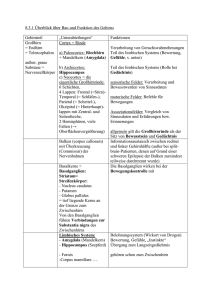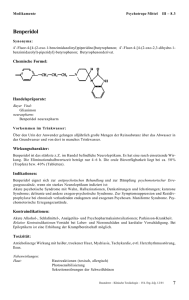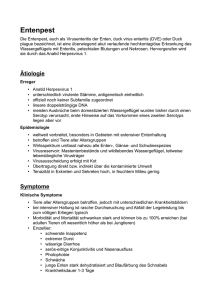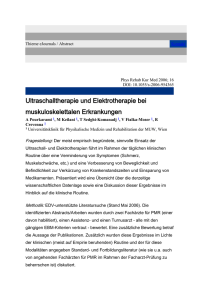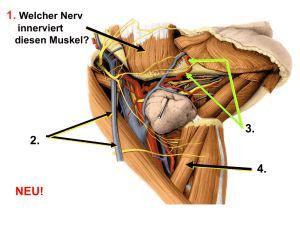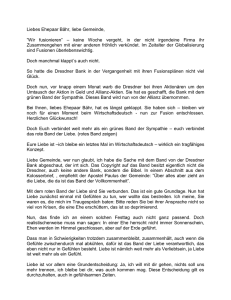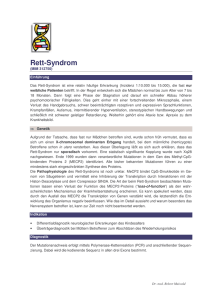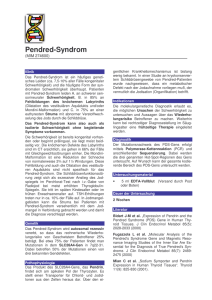Thieme: Neurologisch-topische Diagnostik
Werbung
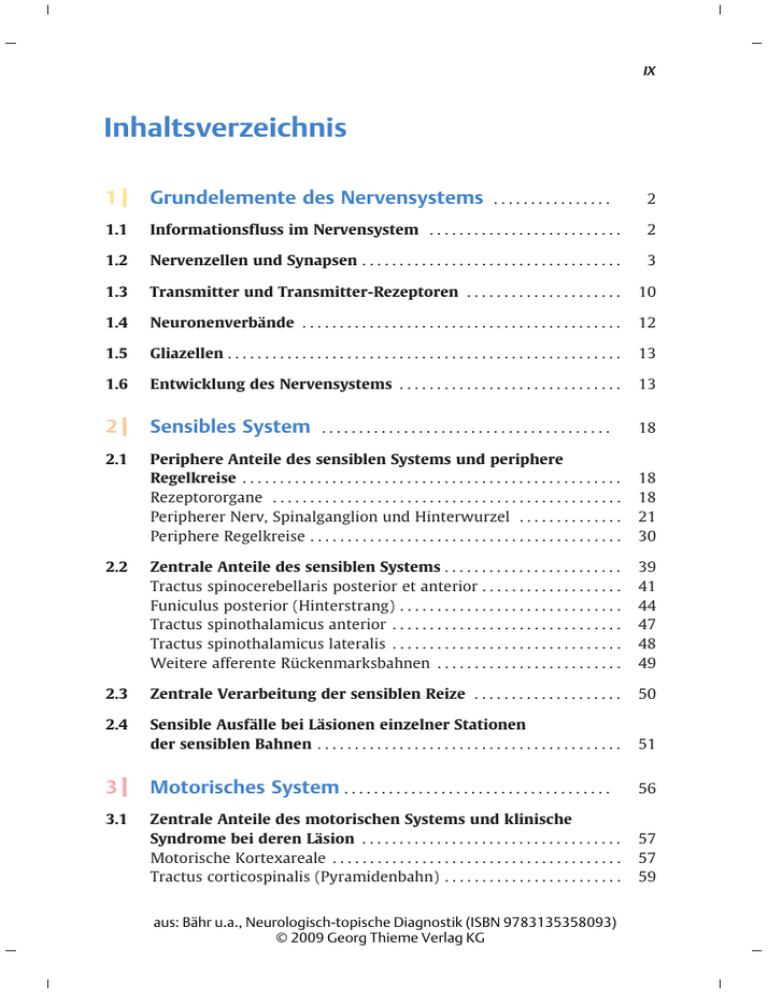
IX Inhaltsverzeichnis 1 Grundelemente des Nervensystems 1.1 Informationsfluss im Nervensystem . . . . . . . . . . . . . . . . . . . . . . . . . . 2 1.2 Nervenzellen und Synapsen . . . . . . . . . . . . . . . . . . . . . . . . . . . . . . . . . . . 3 1.3 Transmitter und Transmitter-Rezeptoren . . . . . . . . . . . . . . . . . . . . . 10 1.4 Neuronenverbände . . . . . . . . . . . . . . . . . . . . . . . . . . . . . . . . . . . . . . . . . . . 12 1.5 Gliazellen . . . . . . . . . . . . . . . . . . . . . . . . . . . . . . . . . . . . . . . . . . . . . . . . . . . . . 13 1.6 Entwicklung des Nervensystems . . . . . . . . . . . . . . . . . . . . . . . . . . . . . . 13 2 Sensibles System 18 2.1 Periphere Anteile des sensiblen Systems und periphere Regelkreise . . . . . . . . . . . . . . . . . . . . . . . . . . . . . . . . . . . . . . . . . . . . . . . . . . . Rezeptororgane . . . . . . . . . . . . . . . . . . . . . . . . . . . . . . . . . . . . . . . . . . . . . . . Peripherer Nerv, Spinalganglion und Hinterwurzel . . . . . . . . . . . . . . Periphere Regelkreise . . . . . . . . . . . . . . . . . . . . . . . . . . . . . . . . . . . . . . . . . . 18 18 21 30 2.2 Zentrale Anteile des sensiblen Systems . . . . . . . . . . . . . . . . . . . . . . . . Tractus spinocerebellaris posterior et anterior . . . . . . . . . . . . . . . . . . . Funiculus posterior (Hinterstrang) . . . . . . . . . . . . . . . . . . . . . . . . . . . . . . Tractus spinothalamicus anterior . . . . . . . . . . . . . . . . . . . . . . . . . . . . . . . Tractus spinothalamicus lateralis . . . . . . . . . . . . . . . . . . . . . . . . . . . . . . . Weitere afferente Rückenmarksbahnen . . . . . . . . . . . . . . . . . . . . . . . . . 39 41 44 47 48 49 2.3 Zentrale Verarbeitung der sensiblen Reize . . . . . . . . . . . . . . . . . . . . 50 2.4 Sensible Ausfälle bei Läsionen einzelner Stationen der sensiblen Bahnen . . . . . . . . . . . . . . . . . . . . . . . . . . . . . . . . . . . . . . . . . 51 3 Motorisches System . . . . . . . . . . . . . . . . . . . . . . . . . . . . . . . . . . . . 56 3.1 Zentrale Anteile des motorischen Systems und klinische Syndrome bei deren Läsion . . . . . . . . . . . . . . . . . . . . . . . . . . . . . . . . . . . Motorische Kortexareale . . . . . . . . . . . . . . . . . . . . . . . . . . . . . . . . . . . . . . . Tractus corticospinalis (Pyramidenbahn) . . . . . . . . . . . . . . . . . . . . . . . . 57 57 59 ................ ....................................... aus: Bähr u.a., Neurologisch-topische Diagnostik (ISBN 9783135358093) © 2009 Georg Thieme Verlag KG 2 X · Inhaltsverzeichnis 3.2 Tractus corticonuclearis (corticobulbaris) . . . . . . . . . . . . . . . . . . . . . . . Weitere zentrale Anteile des motorischen Systems . . . . . . . . . . . . . . Schädigung zentraler motorischer Bahnen . . . . . . . . . . . . . . . . . . . . . . 59 61 64 Periphere Anteile des motorischen Systems und klinische Syndrome bei deren Läsion . . . . . . . . . . . . . . . . . . . . . . . . . . . . . . . . . . . Klinische Syndrome bei Schädigung der motorischen Einheit . . . . 67 69 3.3 Komplexe klinische Syndrome bei Schädigungen einzelner Abschnitte des Nervensystems . . . . . . . . . . . . . . . . . . . . . . . . . . . . . . . . 70 Rückenmarkssyndrome . . . . . . . . . . . . . . . . . . . . . . . . . . . . . . . . . . . . . . . . 70 Nervenwurzelsyndrome (Radikuläre Syndrome) . . . . . . . . . . . . . . . . . 92 Klinische Syndrome bei Plexusschädigungen . . . . . . . . . . . . . . . . . . . . 101 Syndrom der peripheren Nervenläsion . . . . . . . . . . . . . . . . . . . . . . . . . . 106 Störungen im Bereich der neuromuskulären Synapse und im Muskel . . . . . . . . . . . . . . . . . . . . . . . . . . . . . . . . . . . . . . . . . . . . . . . . 110 4 Hirnstamm 4.1 Äußere Struktur des Hirnstamms . . . . . . . . . . . . . . . . . . . . . . . . . . . . . Medulla oblongata . . . . . . . . . . . . . . . . . . . . . . . . . . . . . . . . . . . . . . . . . . . . . Pons . . . . . . . . . . . . . . . . . . . . . . . . . . . . . . . . . . . . . . . . . . . . . . . . . . . . . . . . . . Mesencephalon . . . . . . . . . . . . . . . . . . . . . . . . . . . . . . . . . . . . . . . . . . . . . . . 119 119 121 121 4.2 Hirnnerven . . . . . . . . . . . . . . . . . . . . . . . . . . . . . . . . . . . . . . . . . . . . . . . . . . . Ursprung –Bestandteile – Funktion . . . . . . . . . . . . . . . . . . . . . . . . . . . . Olfaktorisches System (N. I) . . . . . . . . . . . . . . . . . . . . . . . . . . . . . . . . . . . . Optisches System (N. II) . . . . . . . . . . . . . . . . . . . . . . . . . . . . . . . . . . . . . . . . Augenbewegungen (Nn. III, IV und VI) . . . . . . . . . . . . . . . . . . . . . . . . . . Nervus trigeminus (N. V) . . . . . . . . . . . . . . . . . . . . . . . . . . . . . . . . . . . . . . . Nervus facialis (N. VII) und Nervus intermedius . . . . . . . . . . . . . . . . . N. vestibulocochlearis (N. VIII) – kochleäre Komponente und Hörorgan . . . . . . . . . . . . . . . . . . . . . . . . . . . . . . . . . . . . . . . . . . . . . . . . . N. vestibulocochlearis (N. VIII) – vestibuläre Komponente und Vestibularsystem . . . . . . . . . . . . . . . . . . . . . . . . . . . . . . . . . . . . . . . . . . Vagales System (Nn. IX, X und kranial XI) . . . . . . . . . . . . . . . . . . . . . . . N. hypoglossus (N. XII) . . . . . . . . . . . . . . . . . . . . . . . . . . . . . . . . . . . . . . . . . 122 122 129 132 139 161 167 4.3 ............................................... 118 176 185 195 205 Topographische Anatomie des Hirnstamms . . . . . . . . . . . . . . . . . . . 207 Innere Struktur des Hirnstamms . . . . . . . . . . . . . . . . . . . . . . . . . . . . . . . 207 aus: Bähr u.a., Neurologisch-topische Diagnostik (ISBN 9783135358093) © 2009 Georg Thieme Verlag KG Inhaltsverzeichnis · XI 4.4 Erkrankungen des Hirnstamms . . . . . . . . . . . . . . . . . . . . . . . . . . . . . . . 223 Hirnstammsyndrome bei Durchblutungsstörungen . . . . . . . . . . . . . . 223 5 Kleinhirn . . . . . . . . . . . . . . . . . . . . . . . . . . . . . . . . . . . . . . . . . . . . . . . . . . 5.1 Äußere Struktur . . . . . . . . . . . . . . . . . . . . . . . . . . . . . . . . . . . . . . . . . . . . . . 240 5.2 Innerer Aufbau . . . . . . . . . . . . . . . . . . . . . . . . . . . . . . . . . . . . . . . . . . . . . . . Kleinhirnrinde . . . . . . . . . . . . . . . . . . . . . . . . . . . . . . . . . . . . . . . . . . . . . . . . . Kleinhirnkerne . . . . . . . . . . . . . . . . . . . . . . . . . . . . . . . . . . . . . . . . . . . . . . . . Verschaltung von Kleinhirnrinde und Kleinhirnkernen . . . . . . . . . . . 5.3 Verbindungen des Kleinhirns mit anderen Abschnitten des Nervensystems . . . . . . . . . . . . . . . . . . . . . . . . . . . . . . . . . . . . . . . . . . . 246 5.4 Funktionen des Kleinhirns und Kleinhirnsyndrome . . . . . . . . . . . Vestibulocerebellum . . . . . . . . . . . . . . . . . . . . . . . . . . . . . . . . . . . . . . . . . . . Spinocerebellum . . . . . . . . . . . . . . . . . . . . . . . . . . . . . . . . . . . . . . . . . . . . . . Cerebrocerebellum . . . . . . . . . . . . . . . . . . . . . . . . . . . . . . . . . . . . . . . . . . . . 5.5 Erkrankungen des Kleinhirns . . . . . . . . . . . . . . . . . . . . . . . . . . . . . . . . . 256 Zerebelläre Ischämien und Blutungen . . . . . . . . . . . . . . . . . . . . . . . . . . . 256 Kleinhirntumoren . . . . . . . . . . . . . . . . . . . . . . . . . . . . . . . . . . . . . . . . . . . . . 256 6 Zwischenhirn und vegetatives Nervensystem 6.1 Lage und Gliederung des Diencephalons . . . . . . . . . . . . . . . . . . . . . . 261 6.2 Thalamus dorsalis . . . . . . . . . . . . . . . . . . . . . . . . . . . . . . . . . . . . . . . . . . . . Kerngebiete . . . . . . . . . . . . . . . . . . . . . . . . . . . . . . . . . . . . . . . . . . . . . . . . . . . Einbindung der thalamischen Kerngebiete in auf- und absteigende Projektionsbahnen . . . . . . . . . . . . . . . . . . . . . Funktionen des Thalamus dorsalis . . . . . . . . . . . . . . . . . . . . . . . . . . . . . . Syndrome bei Läsionen des Thalamus dorsalis . . . . . . . . . . . . . . . . . . Gefäßsyndrome des Thalamus . . . . . . . . . . . . . . . . . . . . . . . . . . . . . . . . . . .... 240 243 243 245 245 251 252 253 254 260 263 263 264 270 270 272 6.3 Epithalamus . . . . . . . . . . . . . . . . . . . . . . . . . . . . . . . . . . . . . . . . . . . . . . . . . . 273 6.4 Subthalamus . . . . . . . . . . . . . . . . . . . . . . . . . . . . . . . . . . . . . . . . . . . . . . . . . 273 6.5 Hypothalamus . . . . . . . . . . . . . . . . . . . . . . . . . . . . . . . . . . . . . . . . . . . . . . . . 274 Lage und Gliederung . . . . . . . . . . . . . . . . . . . . . . . . . . . . . . . . . . . . . . . . . . . 274 Hypothalamische Kerngebiete . . . . . . . . . . . . . . . . . . . . . . . . . . . . . . . . . . 276 aus: Bähr u.a., Neurologisch-topische Diagnostik (ISBN 9783135358093) © 2009 Georg Thieme Verlag KG XII · Inhaltsverzeichnis Verbindungen des Hypothalamus . . . . . . . . . . . . . . . . . . . . . . . . . . . . . . 276 Funktionen des Hypothalamus . . . . . . . . . . . . . . . . . . . . . . . . . . . . . . . . . 281 6.6 Peripheres vegetatives (autonomes) Nervensystem . . . . . . . . . . . . Grundlagen . . . . . . . . . . . . . . . . . . . . . . . . . . . . . . . . . . . . . . . . . . . . . . . . . . . Sympathisches Nervensystem . . . . . . . . . . . . . . . . . . . . . . . . . . . . . . . . . . Parasympathisches Nervensystem . . . . . . . . . . . . . . . . . . . . . . . . . . . . . . Vegetative Innervation und Funktionsstörungen einzelner Organe . . . . . . . . . . . . . . . . . . . . . . . . . . . . . . . . . . . . . . . . . . . . . . Viszeraler und übertragener Schmerz . . . . . . . . . . . . . . . . . . . . . . . . . . . 289 289 292 295 7 Limbisches System 312 7.1 Übersicht über den Aufbau des limbischen Systems . . . . . . . . . . . 312 Verbindungen der limbischen Strukturen . . . . . . . . . . . . . . . . . . . . . . . 314 7.2 Wichtige Bestandteile des limbischen Systems . . . . . . . . . . . . . . . . 315 Hippocampus . . . . . . . . . . . . . . . . . . . . . . . . . . . . . . . . . . . . . . . . . . . . . . . . . 315 Corpus amygdaloideum . . . . . . . . . . . . . . . . . . . . . . . . . . . . . . . . . . . . . . . . 319 7.3 Funktionen des limbischen Systems . . . . . . . . . . . . . . . . . . . . . . . . . . 319 Gedächtnisarten und -funktionen . . . . . . . . . . . . . . . . . . . . . . . . . . . . . . 320 Störungen der Gedächtnisfunktionen – das amnestische Syndrom und seine Ursachen . . . . . . . . . . . . . . . . . . . . . . . . . . . . . . . . . . 323 8 Basalganglien . . . . . . . . . . . . . . . . . . . . . . . . . . . . . . . . . . . . . . . . . . . . 8.1 Vorbemerkungen zur Terminologie . . . . . . . . . . . . . . . . . . . . . . . . . . . 330 8.2 Position der Basalganglien im motorischen System – entwicklungsgeschichtliche Betrachtung . . . . . . . . . . . . . . . . . . . . . . 331 8.3 Anatomische Gliederung der Basalganglien und ihrer Verbindungen . . . . . . . . . . . . . . . . . . . . . . . . . . . . . . . . . . . . . . 332 Kerngebiete . . . . . . . . . . . . . . . . . . . . . . . . . . . . . . . . . . . . . . . . . . . . . . . . . . . 332 Verbindungen der Basalganglien . . . . . . . . . . . . . . . . . . . . . . . . . . . . . . . 337 8.4 Funktionen und Funktionsstörungen der Basalganglien . . . . . . . 340 Klinische Syndrome bei Basalganglien-Läsionen . . . . . . . . . . . . . . . . . 340 ..................................... aus: Bähr u.a., Neurologisch-topische Diagnostik (ISBN 9783135358093) © 2009 Georg Thieme Verlag KG 297 307 330 Inhaltsverzeichnis · XIII 9 Großhirn . . . . . . . . . . . . . . . . . . . . . . . . . . . . . . . . . . . . . . . . . . . . . . . . . . 9.1 Entwicklung . . . . . . . . . . . . . . . . . . . . . . . . . . . . . . . . . . . . . . . . . . . . . . . . . . 350 9.2 Makroskopische Struktur und Gliederung des Großhirns . . . . . . 354 Gyri und Sulci . . . . . . . . . . . . . . . . . . . . . . . . . . . . . . . . . . . . . . . . . . . . . . . . . 354 9.3 Histologischer Aufbau der Großhirnrinde . . . . . . . . . . . . . . . . . . . . . 358 Schichtaufbau . . . . . . . . . . . . . . . . . . . . . . . . . . . . . . . . . . . . . . . . . . . . . . . . . 359 9.4 Das Marklager . . . . . . . . . . . . . . . . . . . . . . . . . . . . . . . . . . . . . . . . . . . . . . . . Projektionsfasern . . . . . . . . . . . . . . . . . . . . . . . . . . . . . . . . . . . . . . . . . . . . . . Assoziationsfasern . . . . . . . . . . . . . . . . . . . . . . . . . . . . . . . . . . . . . . . . . . . . . Kommissurenfasern . . . . . . . . . . . . . . . . . . . . . . . . . . . . . . . . . . . . . . . . . . . 365 365 366 369 9.5 Funktionelle Zuordnung kortikaler Regionen . . . . . . . . . . . . . . . . . Methodik . . . . . . . . . . . . . . . . . . . . . . . . . . . . . . . . . . . . . . . . . . . . . . . . . . . . . Primäre Rindenfelder . . . . . . . . . . . . . . . . . . . . . . . . . . . . . . . . . . . . . . . . . . Assoziationsareale . . . . . . . . . . . . . . . . . . . . . . . . . . . . . . . . . . . . . . . . . . . . . Frontallappen . . . . . . . . . . . . . . . . . . . . . . . . . . . . . . . . . . . . . . . . . . . . . . . . . Höhere kortikale Funktionen und Funktionsstörungen bei kortikalen Läsionen . . . . . . . . . . . . . . . . . . . . . . . . . . . . . . . . . . . . . . . . 369 369 371 384 385 10 Gehirn- und Rückenmarkshäute, Liquorund Ventrikelsystem . . . . . . . . . . . . . . . . . . . . . . . . . . . . . . . . . . . 350 387 404 10.1 Gehirn- und Rückenmarkshäute . . . . . . . . . . . . . . . . . . . . . . . . . . . . . . Dura mater . . . . . . . . . . . . . . . . . . . . . . . . . . . . . . . . . . . . . . . . . . . . . . . . . . . Arachnoidea . . . . . . . . . . . . . . . . . . . . . . . . . . . . . . . . . . . . . . . . . . . . . . . . . . Pia mater . . . . . . . . . . . . . . . . . . . . . . . . . . . . . . . . . . . . . . . . . . . . . . . . . . . . . 404 404 407 407 10.2 Liquor- und Ventrikelsystem . . . . . . . . . . . . . . . . . . . . . . . . . . . . . . . . . Aufbau des Ventrikelsystems . . . . . . . . . . . . . . . . . . . . . . . . . . . . . . . . . . . Liquorzirkulation und -resorption . . . . . . . . . . . . . . . . . . . . . . . . . . . . . . Störungen der Liquorzirkulation – Hydrocephalus . . . . . . . . . . . . . . . 408 408 408 413 11 Gefäßversorgung und Gefäßerkrankungen des ZNS . . . . . . . . . . . . . . . . . . . . . . . . . . . . . . . . . . . . . . . . . . . . . . . . . . . 420 11.1 Arterielle Blutversorgung des Gehirns . . . . . . . . . . . . . . . . . . . . . . . . . 421 Extraduraler Verlauf der hirnversorgenden Gefäße . . . . . . . . . . . . . . 421 Intradurale Gefäße der vorderen und mittleren Schädelgrube . . . . 423 aus: Bähr u.a., Neurologisch-topische Diagnostik (ISBN 9783135358093) © 2009 Georg Thieme Verlag KG XIV · Inhaltsverzeichnis Intradurale Gefäße der hinteren Schädelgrube . . . . . . . . . . . . . . . . . . 429 Anastomosen bei Stenosen hirnversorgender Arterien . . . . . . . . . . . 434 11.2 Venöser Abfluss des Gehirns . . . . . . . . . . . . . . . . . . . . . . . . . . . . . . . . . . 437 Äußere und innere Hirnvenen . . . . . . . . . . . . . . . . . . . . . . . . . . . . . . . . . . 437 Sinus durae matris . . . . . . . . . . . . . . . . . . . . . . . . . . . . . . . . . . . . . . . . . . . . 439 11.3 Blutversorgung des Rückenmarks . . . . . . . . . . . . . . . . . . . . . . . . . . . . . 441 Arterielles medulläres Gefäßnetz . . . . . . . . . . . . . . . . . . . . . . . . . . . . . . . 441 Venöser Abfluss des Rückenmarks . . . . . . . . . . . . . . . . . . . . . . . . . . . . . . 444 11.4 Zerebrale Ischämie . . . . . . . . . . . . . . . . . . . . . . . . . . . . . . . . . . . . . . . . . . . Arterielle Durchblutungsstörungen . . . . . . . . . . . . . . . . . . . . . . . . . . . . . Spezielle zerebrale Gefäßsyndrome . . . . . . . . . . . . . . . . . . . . . . . . . . . . . Venöse Abflussstörungen des Gehirns . . . . . . . . . . . . . . . . . . . . . . . . . . 445 445 462 471 11.5 Intrakranielle Blutungen . . . . . . . . . . . . . . . . . . . . . . . . . . . . . . . . . . . . . Intrazerebrale Blutungen (nichttraumatisch) . . . . . . . . . . . . . . . . . . . . Blutungen in den Subarachnoidalraum . . . . . . . . . . . . . . . . . . . . . . . . . . Blutungen in Subdural- und Epiduralräume . . . . . . . . . . . . . . . . . . . . . 476 476 479 485 11.6 Spinale Gefäßsyndrome . . . . . . . . . . . . . . . . . . . . . . . . . . . . . . . . . . . . . . . Arterielle Durchblutungsstörungen . . . . . . . . . . . . . . . . . . . . . . . . . . . . . Venöse Abflussstörungen . . . . . . . . . . . . . . . . . . . . . . . . . . . . . . . . . . . . . . Spinale Blutungen . . . . . . . . . . . . . . . . . . . . . . . . . . . . . . . . . . . . . . . . . . . . . 487 487 488 490 Weiterführende Literatur ................................... 493 ............................................... 498 Sachverzeichnis aus: Bähr u.a., Neurologisch-topische Diagnostik (ISBN 9783135358093) © 2009 Georg Thieme Verlag KG
